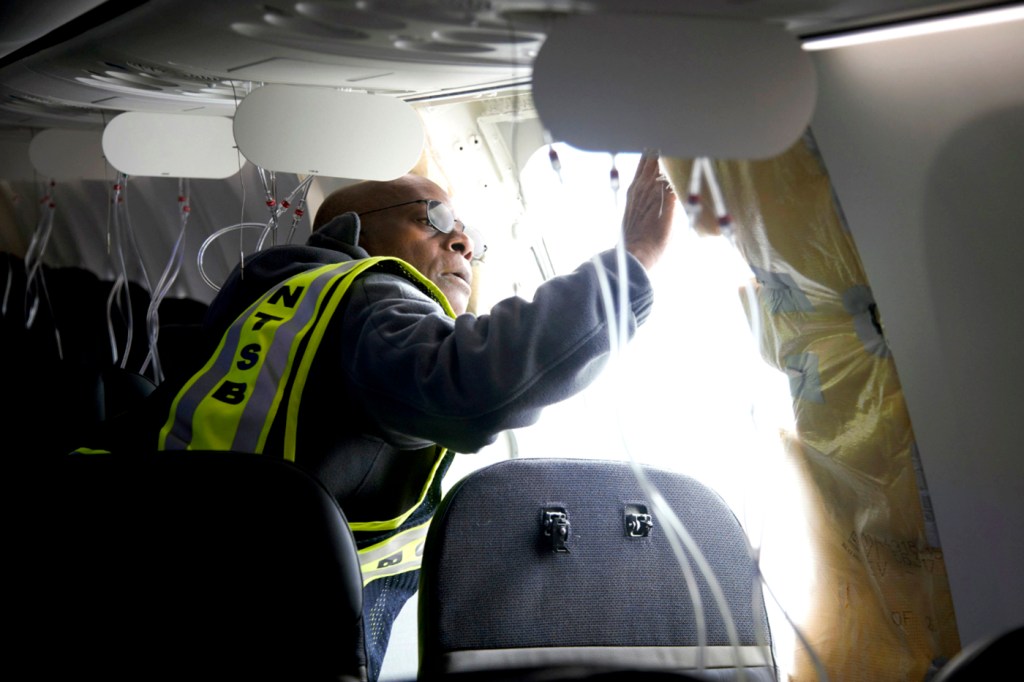The physics of rapid ‘depressurization.’ Passengers on Alaska Airlines Flight 1282 could have died if blowout occurred above 40,000 feet, physicist says

If the Alaska Airlines plane that lost a portion of its fuselage while ascending after takeoff Friday had been flying at normal cruising altitude, its passengers and crew could have died from the depressurization event, according to a Northeastern expert.
The Boeing 737 Max 9 airplane was only minutes into its flight from Portland, Oregon, to Ontario International Airport in San Bernardino County, California, when an unused exit door blew open and detached from the aircraft at an altitude of 16,000 feet, exposing those on board to harrowing conditions that occur when cabin pressure is compromised.
Luckily, none of the passengers or flight crew were seriously injured; but passengers described a scene of chaos: violent winds that ripped headrests off seats, even blowing open the cockpit door from the other end of the plane. Oxygen masks deployed during the chaos — a measure that can help guard against the medical conditions that can arise during rapid depressurization, such as hypoxia and loss of consciousness.
“The best way I can describe it is like puncturing a CO2 canister and that vapor releasing out of the canister,” Evan Smith, a 72-year-old lawyer who was on board, told The New York Times. “But we were in that canister.”
Officials have recovered the door plug — the part of the plane that blew off — in a teacher’s backyard in Portland, Oregon. Officials are still investigating the cause of the incident.
The National Transportation Safety Board said the situation could have easily resulted in tragedy, had there been passengers seated in the row where the door plug was. But the passengers on board won’t soon forget what it was like on the inside of the plane while it was airborne, which was approximately a half-hour.

Northeastern Global News spoke to Arun Bansil, university distinguished professor of physics at Northeastern, to get a better understanding of the science behind keeping an aircraft’s cabin pressure stable, and what elements the crew and passengers may have been exposed to during depressurization.
His comments have been edited for brevity and clarity.
How does an airplane remain pressurized during flight?
Just like a football is inflated by pumping air into it, airplanes are pressurized by pumping appropriately conditioned air into the cabin.
Editor’s Picks
According to reports, the airplane was 16,000 feet above ground when a chunk of the plane (its door plug) blew off, causing a ‘depressurization’ emergency. Can you explain, from a physics standpoint, what that means?
The key physics here is that the atmospheric pressure decreases with increasing altitude. Therefore, the difference in pressure between the outside and inside of the cabin increases with increasing altitude because the pressure in the pressurized cabin is kept constant. If a chunk of the fuselage blows off, the higher-pressure air in the cabin gushes out — like when a filled balloon is punctured — resulting in a depressurization emergency.
When a plane becomes depressurized in this way, and at such altitude and velocity, what would the passengers and crew have experienced?
When the cabin depressurizes, the air pressure and with it the oxygen pressure in the cabin drops, which makes it harder for the lungs to supply adequate amounts of oxygen to the blood. This leads to dizziness and deterioration of cognitive abilities, and eventually to unconsciousness and death. These effects, however, are not that severe for depressurization at 16,000 feet as the time it would take the crew to lose their ability to function usefully if oxygen masks are not deployed would be around 30 minutes. In any event, an airplane can descend from 16,000 feet to the level of breathable air around 10,000 feet in about 30 seconds.
Many observers noted that, were the explosion to have occurred at typical cruising altitude of between 33,000 and 40,000 feet, it could have been potentially deadly for those on board. Can you talk about how the difference in altitude might have been a saving grace?
The higher the altitude, the lower the outside air pressure. The outside pressure is about three times smaller at 40,000 feet compared to 16,000 feet. As a result, physiological effects of rapid depressurization at 40,000 feet are far more severe. Passengers and crew will lose their ability to function usefully in about 10 seconds at 40,000 feet if oxygen masks are not deployed, and death will follow soon thereafter.











